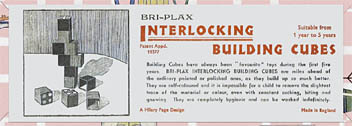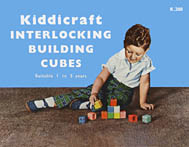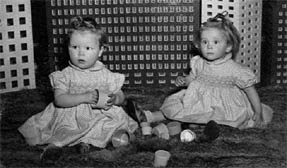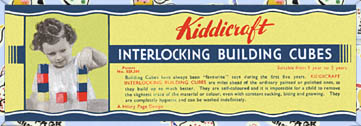Kiddicraft
For more information about Page and Kiddicraft see Chas Saunter’s excellent Hilary Page Toys site. Most of the material here is extracted from our joint “Hilary Fisher Page and Kiddicraft” history. Hilary (Harry) Fisher Page was born on 20 Aug 1904 in Sanderstead, Surrey. He was the first child of Samuel Fisher and Lillian Maude Page. As a child he showed an interest in making toys and inventing his own games. His father, who worked in the lumber trade, once bought him two tons of scrap wood from a local sawmill. This wood pile apparently kept him busy for several years and further sparked his interest in building toys. After his education was finished he, like his father, worked in the timber trade for several years. In 1929 he married Norah Harris, a long-time neighbor and in 1932 their only daughter, Jill, was born.
Kiddicraft
In 1932 Page, along with several partners, decided to go into the toy business. Using Page’s savings of 100 UKP, they opened a small toy shop called “Kiddicraft” at 6 Godstone Road, Purley, Surrey. At first he imported wood toys from Russia, such as stacking rings and matryoshka nesting dolls and later began to introduce his own designs. The business was a struggle and he ended up in bankruptcy court. A period he later described as “most difficult.” Nevertheless he continued to work on new toy designs and, perhaps most importantly, began to seriously study early childhood play. Or more specifically:
1. Page, Hilary Fisher. Playtime in the First Five Years. Second edition. London: Allen & Unwin, 1953. “...he used to spend the whole of every Wednesday in a different nursery school, sitting on the floor and playing with the children, to find out exactly what type of toys would be of the greatest interest to them.” 1
The application of child psychology to toy design, while now commonplace, was revolutionary at the time. The result was a range of toys designed around specific stages of childhood development, a philosophy he described in his first book – Playtime in the First Five Years.
Bri-Plax
Page had become increasingly unhappy with the use of wood as a material for children’s toys and felt that plastics would offer a safe and hygienic alternative:
2. Page, Hilary Fisher. “Plastics as a Medium for Toys.” Daily Graphic Plastics Exhibition Catalog 1946: 112-114. Note that urea refers to to urea-formaldehyde, the thermoplastic used by Page. “...For generations we have tried to find some type of paint or enamel which cannot be sucked or gnawed off, in view of the fact that practically every toy or plaything given to a baby or a young child goes straight to his mouth... Mothers are becoming much more hygienically minded and they realize that every baby’s toy should be thoroughly washed in hot soapy water once a day. This can be done with toys molded from urea. Dust and germs cannot cling to the bright shiny surface, and the range of bright colors is most attractive and interesting to the child.” 2
Throughout the early and mid-1930’s he experimented with molding plastic toys, His partners, however, felt that plastics were simply too risky for the company, Especially one already in a difficult financial position and they persuaded him to form a new company for his experiments – British Plastic Toys Ltd (Bri-Plax).
In 1937 he introduced a line of plastic “Sensible Toys” under the name Bri-Plax. Many of these new designs, such as the Building Beakers, Pyramid Rings, or Billie and his Seven Barrels, were based on the Russian toys he had previously imported. But there were also new designs, such as the Interlocking Building Cube, which would be awarded a British patent in 1940.


The Bri-Plax Interlocking Building Cube
These new “Sensible Toys” became popular with British mothers for exactly the reasons Page had envisioned and the company expanded with a new warehouse in Kenley, Surrey. But whatever success he was beginning to enjoy with the business it was at the expense of his personal life. The stress of the last decade had deteriorated his marriage and he and Norah were separated shortly before the war.
World War II
All of Kiddicraft’s production ceased with the beginning of the war. As part of the British war effort Page toured the US from 1940–42 lecturing and broadcasting on “Children in Wartime” and promoting trade relations between the US and UK. While in Chicago he met his second wife, Oreline, a US citizen, and they were married in Baltimore on 23 July 1941.


The Kiddicraft Interlocking Building Cube
In 1945, as raw materials became available, Page again began marketing his toys. By this time his partners clearly saw the potential of plastics and the toys were marketed under the name Kiddicraft “Sensible Toys.” Advertisements in the trade magazine Games and Toys announced that their “Plastic Educational Toys, in pre-war form, are now available again in limited quantities.” After the war the use of plastics exploded. Soon consumer goods, including toys, made of thermoplastics became commonplace. But by this time Page had a 10 year lead in the field and his post war “Sensible Toys” became very popular in England; his cot and pram designs even won the “Toy of the Year” in 1951.3 3. Although Kiddicraft was the British Toy of the Year in 1951, Lego won the award three times; in 1974, 1975 and 1979 (for Legoland Space), and was also awarded the BATR Toy of the Century in 1999. Sales steadily grew over the next several years and the Kenley warehouse was converted into a small factory.
The Self-Locking Building Brick

Example Kiddicraft Self-Locking Building Bricks
Among the many post-war Kiddicraft designs was a new building block. The Self-Locking Building Bricks were essentially smaller, refined versions of the Interlocking Building Cube. Bricks could be stacked on each other and were held in place by studs on the top. The bricks also featured slits on their side that allowed panel-like doors, windows or cards to be inserted. He patented the basic design, a 2 × 4 studded brick, in 1947. This was later followed by patents for the side slits (1949) and the baseplate (1952).

The original Kiddicraft Self-Locking Building Brick patent


1947 promotional photo and 1948 advertisement
The Kiddicraft Self-Locking Building Brick sets were first marketed in 1947. As a promotion Page and his family built large display models for the 1947 Earls Court Toy Fair.
His daughter Jill remembers “building ‘Sky Scrapers’ that were as tall as I was — 5' 6" ”. The first two sets were soon followed by several more full and supplementary sets.4
4. To confuse matters even more, Page marketed a number of sets with much larger bricks in the mid 1950’s:
 The Self-Locking Building Bricks were
aimed at the older children, and considering the UK market for construction toys at the time, dominated by Meccano, it doesn’t appear that they
were a major part of the Kiddicraft catalog.
The Self-Locking Building Bricks were
aimed at the older children, and considering the UK market for construction toys at the time, dominated by Meccano, it doesn’t appear that they
were a major part of the Kiddicraft catalog.
Ole and Godtfred would copy both the Interlocking Building Cube (as Lego Plastic Byggeskloder) and the Self-Locking Building Brick (as the Automatic Binding Brick). Although Hilary and Oreline visited Ole and Godtfred in 1949, and perhaps, even left drawings and samples, Page was never aware that Lego produced a version of his brick. By this time his focus was on his most ambitious project yet — the Kiddicraft Miniatures.
The Kiddicraft Miniatures
The Kiddicraft Miniatures were small reproductions of actual food and household items, such as detergent boxes, soup cans, tea and sugar boxes, ice cream cartons, beer and wine bottles, even cigarette packs. He promised “over 300” different products and set out on what was, perhaps, the largest licensing arrangement in the toy industry. Kiddicraft eventually produced over 200 of these miniatures but the company simply could not deliver on all of Pages’ promises, and could not honor their agreements with their licensors.
Page became deeply troubled with these pressures on the business and feared a total collapse of the company. Tragically, he committed suicide on 24 June 1957. After Page’s death, David Day, the lead designer, became Managing Director and the company continued. Oreline remained an active director until the company was sold in 1977.
Hestair
In 1977 Oreline sold the company to the Hestair conglomerate. The new, completely restructured company, Hestair-Kiddicraft, continued to produce toys. They marketed many of the older “Sensible Toys” as well as a number of new toys, mostly designed by David Day. The company even moved to larger headquarters in Bristol in 1984. Hestair sold the company to Fisher-Price in 1989. Fisher-Price used the Kiddicraft brand name, but none of the classic Page and Day designs. In the mid 1990’s Fisher-Price finally dropped the Kiddicraft brand. It was the apparent end of the Kiddicraft brand and their toys.


